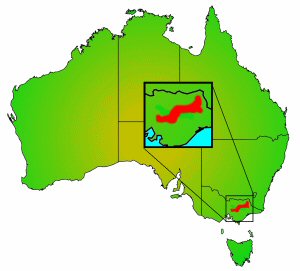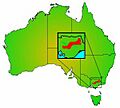Riffle galaxias facts for kids
Quick facts for kids Riffle galaxias |
|
|---|---|
| Conservation status | |
| Scientific classification | |
| Kingdom: | |
| Phylum: | |
| Class: | |
| Order: |
Osmeriformes
|
| Family: | |
| Subfamily: | |
| Genus: |
Galaxias
|
| Species: |
G. arcanus
|
| Binomial name | |
| Galaxias arcanus Raadik, 2014
|
|
The riffle galaxias (scientific name: Galaxias arcanus) is a special type of freshwater fish. It belongs to a family called galaxiids. This fish is part of a larger group known as the Mountain Galaxias complex. You can find the riffle galaxias living in rivers and streams in Australia.
Contents
Meet the Riffle Galaxias: What It Looks Like
The riffle galaxias has a body shape typical of other galaxias fish. It has a long, tube-like body. The longest one ever found was about 98 millimeters (almost 4 inches) long. Most of them are usually between 60 to 75 millimeters (2.4 to 3 inches) long.
Fins and Body Shape
Its fins are thin and moderately long. They look a bit like paddles. The fins near its belly are about halfway along its body. The fin on its back is a bit further back. The tail fin is moderately lobed and a bit shorter than the part of the body just before the tail.
Colors and Patterns
The fish is usually a beige to olive-brown color on top. Its underside is silvery white. It has large, blotchy dark markings over its main color. These often merge into uneven bands. You might also see tiny dark grey spots. Sometimes, it has one or two horizontal bands of gold or copper-colored flecks. These flecks can also be on its head and snout.
Where the Riffle Galaxias Lives: Distribution
The riffle galaxias lives in a small area in eastern Victoria, Australia. This area is north of the Great Dividing Range, which is a large mountain range. In the west, it lives near the start of the Goulburn River. In the east, it can be found near the start of the Murray River.
Why It Stays in Certain Areas
This fish might only live in steeper streams in higher areas. This is because it needs certain conditions to survive. It prefers places with different types of rocks and faster water flows. It has not been found in all parts of the Murray River downstream from Albury.
Home Sweet Home: The Riffle Galaxias Habitat
The riffle galaxias loves cold, clear water. It lives in shallow, fast-flowing streams. These streams are usually 100 to 400 millimeters (4 to 16 inches) deep. They can be anywhere from 1 to 20 meters (3 to 65 feet) wide. These fish live at elevations between 150 and 880 meters (490 to 2,890 feet) above sea level.
Preferred Stream Areas
You will often find this fish in areas with lots of energy, like "riffles" and "runs." Riffles are shallow, fast-moving parts of a stream where the water flows over rocks. Runs are deeper, faster-moving areas. The bottom of these streams usually has pebbles and rocks. There might also be some bedrock, boulders, and gravel.
Hiding Spots
The riffle galaxias usually hides among or under rocks. It also likes to hide in the gaps between the rocks on the stream bed. It does not usually live among plants in the water. However, it can sometimes be found near submerged wood debris.
Staying Safe from Predators
Riffle galaxias often share their streams with many trout, which are fish that hunt them. But the riffle galaxias has ways to protect itself. It likes fast-moving water and hides between rocks. Its colors also help it blend in with its surroundings. This helps it stay safe from predators.
Life Cycle and Reproduction
The riffle galaxias likely lays its eggs between October and December. Sometimes, it might even lay eggs into January. Scientists have found adult fish ready to lay eggs in early November in Corryong Creek. They also found them in the Acheron River from mid-October to mid-November.
Young Fish on the Move
Young riffle galaxias have been seen swimming together in large groups. These groups can have more than fifty fish. They move upstream along the shallow edges of pools. This suggests that the younger fish actively travel upstream to new areas.
Riffle Galaxias and Humans
People do not usually try to catch the riffle galaxias for fishing. This is because they are quite small.
Images for kids




